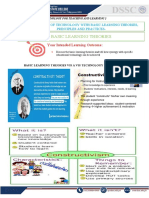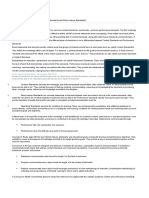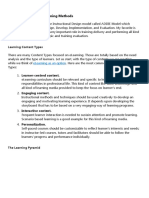0 ratings0% found this document useful (0 votes)
1 viewsTTL2 Notes
Uploaded by
mabelinchariesCopyright
© © All Rights Reserved
Available Formats
Download as DOCX, PDF, TXT or read online on Scribd
0 ratings0% found this document useful (0 votes)
1 viewsTTL2 Notes
Uploaded by
mabelinchariesCopyright
© © All Rights Reserved
Available Formats
Download as DOCX, PDF, TXT or read online on Scribd
You are on page 1/ 3
Learning outcomes represent one of the essential building blocks for
transparency within higher education systems and qualifications
Revised Bloom's taxonomy refers to the emphasis on two learning domains
that make up educational objectives: cognitive (knowledge) and affective
(attitude).
Focus on teaching – aims and objectives and use of terms like know,
understand, be familiar with.
Outcomes: Focus on what we want the student to be able to do - use of terms
like define, list, name, recall, analyse, calculate, design, etc.
Constructive- The students construct understanding for themselves through
learning activities.
Alignment- refers to what the teacher does in helping to support the learning
activities to achieve the learning outcomes.
Assessment for learning- gives feedback to students and teachers to help
modify teaching and learning activities, i.e. helps inform teachers and students
on progress being made.
Continuous Assessment- A combination of summative and formative
assessment.
Knowledge – the conceptual frameworks of the discipline
Methods – how experts think in the discipline
Peer Assessment- Student to Student – must build up a culture of positive peer
assessment over time
Criterion referenced- Setting out in a public manner the criteria to be used for
assessment
Normative: Setting and achieving a class norm
Respectful- reveals uniqueness of learners; free of bias
Scaffolding- is a temporary framework that is put up for support and access to
meaning and is taken away when the student feels success and masters tasks,
concepts, and, in this case, language acquisition.
Setting Up the Presentation Class – It is not enough to simply tell students to
go and do a presentation. Students have to be taught the skills involved in giving
a presentation. This can include such things as when to use eye contact, how to
organize a presentation, how to connect with and audience, how to use the body
language, and, manage time.
Organization of the Presentation – Proper organization of presentation is one
of the most important competencies that must be developed among students.
Before beginning to work, on developing presentation, it is important to
understand the genre of oral presentation.
Presentation Skills – It’s developing oral presentation is very important to
consider in developing oral presentation to spend time to consider the macro
and micro skills that are needed.
The use of visual aids – Visual aids are important part of the oral presentations
because they provide support for both the speakers and listeners during
presentation.
Performing Self-Reflection – The final stage of each oral presentations
involves students writing a self-reflection of their presentation.
Drop Box – This is a free online word processor offered by the online cloud
storage provider.
Office Online – For Microsoft word and office presentation, the best possible
free online alternative for their document editing needs is word online, which
comes as part of the office online suite.
Google Docs- Allows you to create, collaborate and share documents,
spreadsheets, presentations, drawings and even forms.
Etherpad- is an online document editor primarily intended for collaborative
editing in, as the site claims, “really real time”.
AbiWord- is a free word processing application very similar to Microsoft Word.
The Diary Project- This digital authoring website encourages students to
contribute their narrations or daily diaries with different themes required by the
website.
Cyberkids- it is to provide voice for young people on the internet.
Stellar- is a free storytelling application developed by Mombo Labs, which lets
you create photo and video stories with an emphasis on design.
Book Creator- is an open-ended book creation app that unleashes creativity.
Microsoft Word- does not only allow you to create documents but it also has a
provision to allow you to create charts or graphs that will add to the visual
appeal of the presentation of your text.
Microsoft Excel- One of the main features and other spreadsheets application
is to create charts and graphs.
Microsoft Powerpoint- offers various tools that can make your presentation
interactive.
You might also like
- Using Open-Ended Tools in Facilitating Learning44% (9)Using Open-Ended Tools in Facilitating Learning6 pages
- Basic Instructional Design in Preparing PresentationNo ratings yetBasic Instructional Design in Preparing Presentation1 page
- Theories and Principles in The Use of Technology100% (1)Theories and Principles in The Use of Technology7 pages
- Module-5_Productivity-Software-Applications-for-Teaching-and-Learning (1)No ratings yetModule-5_Productivity-Software-Applications-for-Teaching-and-Learning (1)27 pages
- On Track Scheme of Work Unit 4289 - Documents For A PurposeNo ratings yetOn Track Scheme of Work Unit 4289 - Documents For A Purpose13 pages
- Best Practices Guide For Instructional DesignNo ratings yetBest Practices Guide For Instructional Design8 pages
- Productivity Software Applications Science Teaching and Learning71% (7)Productivity Software Applications Science Teaching and Learning27 pages
- Uw Stout Instructional Design Program OverviewNo ratings yetUw Stout Instructional Design Program Overview4 pages
- LEAD+605+Syllabus+Spring+2025+Subterm+1No ratings yetLEAD+605+Syllabus+Spring+2025+Subterm+114 pages
- Staff Guide To The E-Portfolio at The Language Centre2011-12No ratings yetStaff Guide To The E-Portfolio at The Language Centre2011-122 pages
- Developing E-Learning Materials For Software Development CourseNo ratings yetDeveloping E-Learning Materials For Software Development Course7 pages
- Co Operative Education Revised June 2011No ratings yetCo Operative Education Revised June 201150 pages
- ADDIE Instructional Design Certificate ProgramNo ratings yetADDIE Instructional Design Certificate Program12 pages
- Choosing The Right Tools For Online Collaboration ToolsNo ratings yetChoosing The Right Tools For Online Collaboration Tools4 pages
- TT 3 7 A Users Guide To Reflective Practice 2008No ratings yetTT 3 7 A Users Guide To Reflective Practice 200823 pages
- Web Based Virtual Learning Environments Experiences and FuturesNo ratings yetWeb Based Virtual Learning Environments Experiences and Futures2 pages
- Basic Productivity Presentation Tool Lesson IdeaNo ratings yetBasic Productivity Presentation Tool Lesson Idea3 pages
- Designing Successful e-Learning: Forget What You Know About Instructional Design and Do Something InterestingFrom EverandDesigning Successful e-Learning: Forget What You Know About Instructional Design and Do Something InterestingNo ratings yet
- Module 2 - Handout 2.0 - Demand Theory, Analysis and EstimationNo ratings yetModule 2 - Handout 2.0 - Demand Theory, Analysis and Estimation4 pages
- Mechanical Liquid Flow Switch: Penn Commercial RefrigerationNo ratings yetMechanical Liquid Flow Switch: Penn Commercial Refrigeration2 pages
- Pattern Recognition Letters: Xiaohua Xia, Suping Fang, Yan XiaoNo ratings yetPattern Recognition Letters: Xiaohua Xia, Suping Fang, Yan Xiao6 pages
- Ash Handling System: in A 210 M.W Boiler, The Coal Consumption Is 3,500 M.T S Per Day The Ash Content Is 1,400 M.T SNo ratings yetAsh Handling System: in A 210 M.W Boiler, The Coal Consumption Is 3,500 M.T S Per Day The Ash Content Is 1,400 M.T S22 pages
- Clincal Guidelines For Genetics Services 2021No ratings yetClincal Guidelines For Genetics Services 202173 pages
- Apollo and Lumina - Crystal Wind™ - ElohimNo ratings yetApollo and Lumina - Crystal Wind™ - Elohim7 pages
- St. Bernard Parish Gov't v. United States, No. 05-1119L (Fed. Cl. May 1, 2015)100% (1)St. Bernard Parish Gov't v. United States, No. 05-1119L (Fed. Cl. May 1, 2015)74 pages
- Download Principles of Population Genetics 4th Edition Daniel L. Hartl ebook file with all chapters100% (1)Download Principles of Population Genetics 4th Edition Daniel L. Hartl ebook file with all chapters37 pages
- System Oriented Sustainable Supply Chain Management Innovations in Automotive Industry - SKODA Auto Case StudyNo ratings yetSystem Oriented Sustainable Supply Chain Management Innovations in Automotive Industry - SKODA Auto Case Study7 pages

























































































